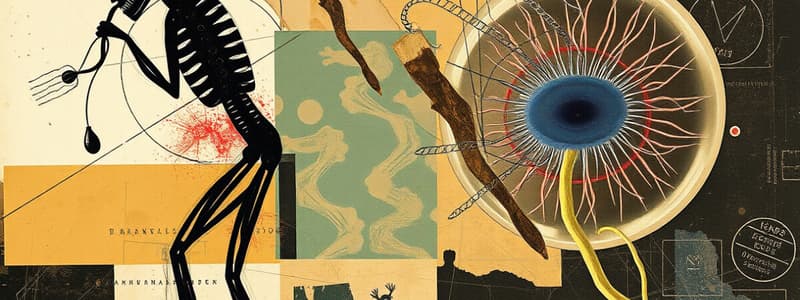Podcast
Questions and Answers
What is gametogenesis?
What is gametogenesis?
Conversion of germ cells into male and female gametes.
What are primordial germ cells (PGCs)?
What are primordial germ cells (PGCs)?
Cells formed in the epiblast during the 2nd week of embryonic development.
At the end of the 5th week, primordial germ cells migrate towards the developing ______.
At the end of the 5th week, primordial germ cells migrate towards the developing ______.
gonads
What can teratomas contain?
What can teratomas contain?
How many chromosomes do humans have?
How many chromosomes do humans have?
The SRY gene codes for the protein ______.
The SRY gene codes for the protein ______.
The Müllerian ducts develop into the male reproductive organs.
The Müllerian ducts develop into the male reproductive organs.
What does mitosis produce?
What does mitosis produce?
What is produced at the end of meiosis I in humans?
What is produced at the end of meiosis I in humans?
Mitosis involves two divisions.
Mitosis involves two divisions.
Flashcards are hidden until you start studying
Study Notes
Gametogenesis
- Gametogenesis involves the conversion of primordial germ cells (PGCs) into male and female gametes.
- PGCs form in the epiblast during the second week of embryonic development and migrate to the yolk sac wall.
- By the fourth week, PGCs move toward developing gonads, reaching them by the end of the fifth week.
Epiblast
- The epiblast is responsible for giving rise to all three germ layers and the primordial germ cells.
Clinical Correlates: Teratomas
- Teratomas are tumors containing diverse tissues, including bone, muscle, hair, and gut epithelium.
- They may originate from pluripotent stem cells or from PGCs that deviate from their migratory pathways during gastrulation.
Chromosome Theory of Inheritance
- Traits are determined by specific genes located on chromosomes inherited from both parents.
- Humans possess approximately 23,000 genes distributed across 46 chromosomes.
- Genes located on the same chromosome tend to be linked and inherited together.
- There are 22 pairs of autosomes and one pair of sex chromosomes in humans.
Sex Determination
- Primary sex determination is influenced by the SRY gene, located on the Y chromosome.
- The SRY gene encodes the testis-determining factor (TDF), which directs the differentiation of the bipotential gonad into a testis.
Bipotential to Specific Gonads
- The Wolffian duct develops into male genital structures, aided by Müllerian inhibiting hormone, which causes atrophy of the Müllerian ducts.
- The Müllerian duct is responsible for forming female reproductive organs.
Mitosis
- Mitosis is the process by which a single somatic cell divides into two identical daughter cells, each containing 46 chromosomes.
- DNA replication occurs prior to mitosis during the S phase.
Meiosis
- Meiosis is a specialized cell division that occurs in germ cells, reducing chromosome numbers by half to produce haploid gametes.
- The process consists of two divisions and includes stages such as DNA replication, synapsis, crossing-over, and the formation of chiasma.
- At the conclusion of meiosis I, each daughter cell possesses 23 unique chromosomes, indicating a haploid state.
Studying That Suits You
Use AI to generate personalized quizzes and flashcards to suit your learning preferences.




